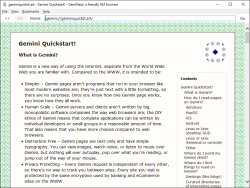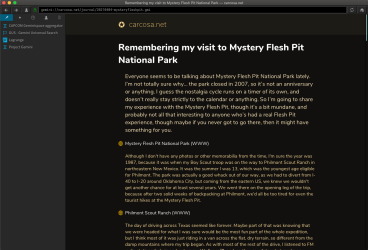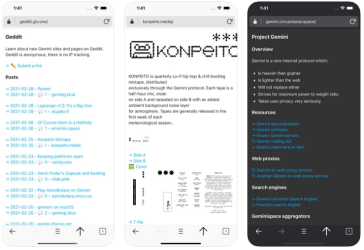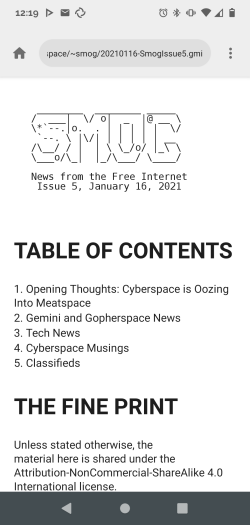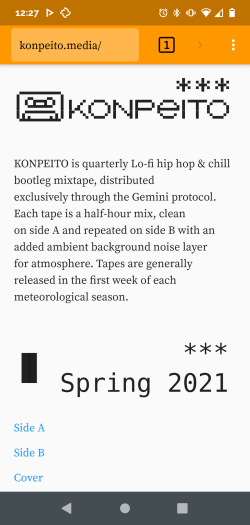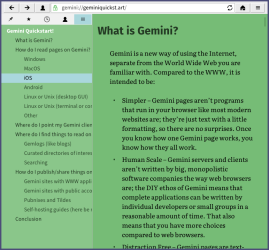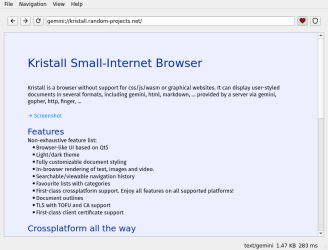What is Gemini?
Gemini is a new way of using the Internet, separate from the World Wide Web you are familiar with. Compared to the WWW, it is intended to be:
- Simpler – Gemini pages aren’t programs that run in your browser like most modern websites are; they’re just text with a little formatting, so there are no surprises. Once you know how one Gemini page works, you know how they all work.
- Human Scale – Gemini servers and clients aren’t written by big, monopolistic software companies the way web browsers are; the DIY ethos of Gemini means that complete applications can be written by individual developers or small groups in a reasonable amount of time. That also means that you have more choices compared to web browsers.
- Distraction Free – Gemini pages are text-only and have simple typography. You can view images, watch video, or listen to music over Gemini, but nothing will ever autoplay, pop over what you’re reading, or jump out of the way of your mouse.
- Privacy Protecting – Every Gemini request is independent of every other, so there’s no way to track you between sites. Every site you visit is protected by the same encryption used by banking and eCommerce sites on the WWW.
More details are in the Official Gemini FAQ. Be aware that it’s targeted at a more technical audience than this quick start page, so you might want to skip it for now and come back later. The main thing to know is that you’re going to get a much more stripped-down experience compared to the modern WWW, but that’s okay! Some of the choices made to keep Gemini simple may seem too extreme, compared to even a bare-bones web site, but there are hidden benefits that won’t be obvious at first.
How do I read pages on Gemini?
The first thing to do is to install a Gemini client. A Gemini client is like a web browser, except instead of browsing the web, it browses Geminispace. There are at least a couple of Gemini clients available for most platforms. Here, I’m going to recommend just one, that I think will feel most familiar or least surprising to new users. That doesn’t mean I think the other ones are bad. A lot of it is just personal preference, just like with web browsers. After you get used to Gemini with the client I recommend, you may want to try some others.
You may be used to doing everything in the web browser, and find it strange or uncomfortable to have to install a different program to read Gemini pages. But you’ll get used to it; the WWW tries to be everything to everyone, both a floor-wax and a toothpaste, while Gemini tries to be good at just one thing.
Windows
You have several options for a Gemini browser on Windows, but I’m going to recommend that you install Geminaut, because of its comfortable, Windows-native user interface. Download and run the latest MSI file from the website. You will get a warning that the installer isn’t signed, which is because the developer is an independent hobbyist. If you downloaded it directly from the link above, it should be safe to “run anyway”.
Lagrange is another good option – it has more features and is lightweight, but the user interface isn’t native like GemiNaut’s. There is also a nightly build of Kristall.
MacOS
There are several Gemini clients that can be built for MacOS, but the only one I know of that provides pre-built downloads for a released version is Lagrange. That’s okay, because Lagrange is a very good browser. The UI doesn’t use native controls, but it’s light and fast.
There may also be nightly builds of Kristall, if you’re so inclined.
iOS
There is one Gemini client on the app store, called Elaho. There is another one on TestFlight called Rocketeer.
Android
For Android, I recommend Ariane. The developer’s site has several different download options, but if you are at all unsure, you should install from Google Play.
Deedum is also a good client for Android, but its UI is not quite as simple.
Linux or Unix (desktop GUI)
If you’re able to compile programs from source, you are spoiled for choice. Most Gemini clients are developed for Linux. The main GUI choices are:
If you need a binary release, you will probably need to install Lagrange. Lagrange is on FlatHub, so if your distribution supports FlatPaks, you’re in luck. There is also a nightly AppImage of Kristall, if you prefer.
Linux or Unix (terminal or console)
The situation here is similar to Linux GUI clients, but there are at least two that have binary releases:
If you’re not sure which you want, go for Amfora; it has more familiar keybindings than Bombadillo.
Other
If there’s no Gemini client for your platform, but there is a web browser, you can use a proxy. Either portal.mozz.us or proxy.vulpes.one should work for your needs.
You shouldn’t use a proxy just because you don’t want to install a Gemini client, though! You will miss out on the experience of not using the web browser.
Where do I point my Gemini client?
By now, you should have a Gemini client installed. If you’ve tried to install one, but gotten stuck, please feel free to give me an email at help@geminiquickst.art. I don’t mind! You can do this next part using one of the web portals, but it would be better if you had a real client installed.
First, open up your Gemini client, and arrange it so that you can see both the
Gemini client and the web browser you’re reading this in. You should be able to
follow the rest of this tutorial in Gemini. In your Gemini client, open
gemini://geminiquickst.art/. You may or may not
be able to click on that link from your web browser and have it open up in your
Gemini client, depending on a lot of nerd stuff that you don’t have to care
about now. If it doesn’t open up on click, copy and paste
gemini://geminiquickst.art/ into your Gemini client. You should get a page
that’s pretty much the same as this one, though the colors and fonts may be
different. Scroll it down until you reach this point, then read the rest of your
page in your Gemini client, rather than your web browser.
Where do I find things to read on Gemini?
Gemini is pretty new, so like the early web, there’s not as much content as you’re used to on the modern web, and too much of it is tech stuff. But there’s a lot of other stuff there too, if you’re willing to look.
Gemlogs (like blogs)
One of the main things people have been using Gemini for is blogging. And it makes sense, because blogs are mostly text, it’s easy to find updates, and the web has made a real mess of it, where it hasn’t completely abandoned it to social media.
Several of the clients recommended above have built in feed-readers for subscribing to gemlogs and staying informed about updates. If yours does, I recommend that you take advantage of that feature as you find gemlogs you want to read. It will be more flexible than depending on a feed aggregator hosted by someone else, and easier than setting up your own feed aggregator.
But to find feeds to subscribe to, you’re best off starting with an aggregator someone else is running. This is a list of well-known public aggregators in Geminispace.
- CAPCOM is run by Solderpunk, the founder of the Gemini project. It knows about over 200 Gemini feeds, but picks 100 every month to display. It’s a good way of finding feeds to follow.
- Spacewalk is an aggregator that follows every update to the pages it follows. This makes it a little less accurate than CAPCOM, but can follow pages that don’t announce their updates.
- gmisub aggregates over 100 feeds using the Gemini simple feed specification.
Curated directories of interesting pages by topic
Because Geminispace is a lot smaller than the web, it’s still somewhat possible to hand-curate a list of interesting sites. You may remember how Yahoo! got its start as a curated index of links by topic.
- Medusae.space is an index similar to the old Yahoo!. You can browse by topic, or search.
- Gemini Discovery is a index of search engines and indices you can use to find things you’re interested in.
Searching
You can also search Gemini, just like you can search the web. However, it’s not indexed by Google or Bing or DuckDuckGo; we have our own search engines. Or rather, search engine. There have been three search engines built for Gemini, but only one is currently active: Geminispace.info.
That said, search is not as important, currently, on Gemini as it is on the WWW. Subscriptions and cross-site links are the main ways of finding new things.
How do I publish/share things on Gemini?
This part is a little harder, but people are busily working on making it easier! The first thing that you should know is that there’s no direct equivalent of the WWW’s social media sites on Gemini. Gemini doesn’t have a built-in method for posting things, so most people posting on Gemini right now are using separate tools to write their pages or posts and to upload them to a server. And that’s leaving out registering an account on the server, which is usually done manually by the site owner! But that situation is going to get better. Right now, there are a few Gemini sites where the “separate tools” for registering an account and posting pages or updates are web applications, and it’s likely that someone will make an integrated native application.
Gemini sites with WWW applications for posting
- The Midnight Pub is a hybrid Gemini site with a “local pub” theme. Some people post regular gemlogs, some people role-play the part of patrons at the pub. It’s kind of a slow-paced social media site. Registration requires emailing the bartender to ask them for a key, but don’t be shy – they just want to make sure you’re not a spammer. People can subscribe to a feed of just your posts, or a feed of everyone at the pub.
- Gemlog.Blue is a site that makes it easy to maintain a gemlog. You can register on the WWW side of the site, and create, edit, or delete posts through the web interface, and view them through Gemini. People can subscribe to a feed of your posts.
- Flounder is another site with a web application for posting. It’s more general-purpose than Gemlog.Blue or the Midnight Pub. The registration page asks where you heard about Flounder, but it’s really just a low-tech anti-spam measure. Tell them this page sent you.
Gemini sites with public account signup
Shared hosting on Gemini today is pretty similar to shared hosting on the WWW in 1999, but in general more community-oriented and friendlier. If you think of these sites as being like GeoCities, but without neon backgrounds and blinking “under construction” GIFs, you won’t be too far wrong.
With these sites, you will sign up, either via the web or email, and have a space that you can access with a native graphical file transfer application such as FileZilla (Windows, MacOS, or Linux). You’ll write Gemtext documents on your own computer, then copy them to your host with Filezilla or a similar program. Some of these sites will want you to send an SSH public key, which may sound too technical, but Digital Ocean has a pretty good guide to using them with FileZilla. It’s focused on their own VPS service, but most of it should apply here, too.
One warning – if you’re on Windows and you’re not careful with how you install Filezilla, you may end up with some additional bundled software you don’t want. For Windows users, I recommend Winscp as an alternative.
- pollux.casa offers free Gemini hosting on subdomains (like ‘yourname.pollux.casa’) that are also reachable by http. Sign-up is by email to Adële, the host, and access to your files is by SFTP or FTPS. Overall, this seems like one of the most friendly site hosting options for newcomers.
- If you are a French speaker, you might look at Un bon café, a French Gemini hosting service that aims to be simple and use sFTP for uploading content. They also offer an email hosting service. The service is free.
- koyu.space offers free hosting. Unlike some of the others, your site gets automatically updated from a git repository you maintain, so this one is probably not best for non-technical people, unless you have a hankering to learn git.
- SourceHut Pages offers free Gemini hosting. Their setup is probably more complex than non-technical users will want to engage with, but it’s free, and it’s somewhat less involved than running your own Gemini server.
- Jae’s Gemini pod offers free hosting, on a subdomain or your own domain. You’ll need to send the owner a SSH public key, a name for your website, and the domain name or subdomain you want to use.
- Main Street in Nightfall City offers Gemini, Gopher, and WWW hosting at the center of downtown Nightfall City, home of the Midnight Pub. The hosting here is a little more hands-on, but more flexible. You’ll need an account name and SSH public key. The online help focuses on terminal tools, but you should be able to use FileZilla or similar to upload your pages.
- si3t.ch offers free shared hosting. Your capsule will have its own subdirectory. Instructions are on the site.
Pubnixes and Tildes
A pubnix is a PUBlic uNIX server, a kind of shared computer for use by members of a community. They’re usually used by logging in to a terminal interface using an SSH (secure shell) client. That’s actually a very good way to dip your toes into the more technical side of Gemini (and Gopher, and WWW) hosting, but it’s understandable if it’s not for you. Many pubnixes offer Gemini hosting to their members.
These are a few pubnixes with Gemini hosting:
- The Mare Crisium Soviet Socialist Regency
- The Mare Tranquillitatis People’s Circumlunar Zaibatsu
- The Mare Serenitatis Circumlunar Corporate Republic
- Ctrl-C Club
- envs.net
- heathens.club
- Park City
- RawTextClub
- SDF Public Access UNIX System
- tilde.pink
Self-hosting guides (here be monsters)
It’s not hard, as these things go to set up a Gemini server on a VPS (Virtual Private Server), a collocated server, or a Raspberry Pi in a shoebox under the bookshelf your router sits on. However “as these things go” covers a lot of evils. You’ll generally need to be familiar with the Unix or Linux command-line, installing software from a distribution repository, and with compiling software from source.
I do not yet have any How-To documents collected for self-hosting a Gemini server. Please let me know if you find or write one!
Conclusion
That’s it! Hopefully by this point you have found some things you want to read on Gemini, ideally things you’ve subscribed to that will keep you coming back. And if things have gone really well, you’ll have established a foothold of your on in Geminispace, and I’ll be reading something you’ve shared in not too long.
If any of the steps in this document were unclear or you need help for another reason, please feel free to email help@geminiquickst.art.
If you see something that’s missing (like a hosting site you want to recommend), or something wrong, please mail info@geminiquickst.art.
Thank you for reading! See you out there!
